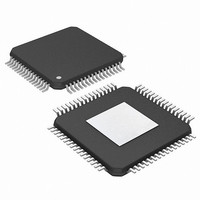PIC24FJ256DA210T-I/BG Microchip Technology, PIC24FJ256DA210T-I/BG Datasheet - Page 82

PIC24FJ256DA210T-I/BG
Manufacturer Part Number
PIC24FJ256DA210T-I/BG
Description
16-bit, 256KB Flash, 96K RAM, USB, Graphics 121 XBGA 10x10x1.20mm T/R
Manufacturer
Microchip Technology
Series
PIC® 24Fr
Specifications of PIC24FJ256DA210T-I/BG
Core Processor
PIC
Core Size
16-Bit
Speed
32MHz
Connectivity
I²C, IrDA, SPI, UART/USART, USB OTG
Peripherals
Brown-out Detect/Reset, GFX, LVD, POR, PWM, WDT
Number Of I /o
84
Program Memory Size
256KB (85.5K x 24)
Program Memory Type
FLASH
Ram Size
96K x 8
Voltage - Supply (vcc/vdd)
2.2 V ~ 3.6 V
Data Converters
A/D 24x10b
Oscillator Type
Internal
Operating Temperature
-40°C ~ 85°C
Package / Case
121-TFBGA
Lead Free Status / RoHS Status
Lead free / RoHS Compliant
Eeprom Size
-
Lead Free Status / RoHS Status
Lead free / RoHS Compliant
Available stocks
Company
Part Number
Manufacturer
Quantity
Price
Company:
Part Number:
PIC24FJ256DA210T-I/BG
Manufacturer:
Microchip Technology
Quantity:
10 000
- Current page: 82 of 408
- Download datasheet (4Mb)
PIC24FJ256DA210 FAMILY
5.2
The PIC24F Flash program memory array is organized
into rows of 64 instructions or 192 bytes. RTSP allows
the user to erase blocks of eight rows (512 instructions)
at a time and to program one row at a time. It is also
possible to program single words.
The 8-row erase blocks and single row write blocks are
edge-aligned, from the beginning of program memory, on
boundaries of 1536 bytes and 192 bytes, respectively.
When data is written to program memory using TBLWT
instructions, the data is not written directly to memory.
Instead, data written using table writes is stored in
holding latches until the programming sequence is
executed.
Any number of TBLWT instructions can be executed
and a write will be successfully performed. However,
64 TBLWT instructions are required to write the full row
of memory.
To ensure that no data is corrupted during a write, any
unused
FFFFFFh. This is because the holding latches reset to
an unknown state, so if the addresses are left in the
Reset state, they may overwrite the locations on rows
which were not rewritten.
The basic sequence for RTSP programming is to set up
a Table Pointer, then do a series of TBLWT instructions
to load the buffers. Programming is performed by
setting the control bits in the NVMCON register.
Data can be loaded in any order and the holding regis-
ters can be written to multiple times before performing
a write operation. Subsequent writes, however, will
wipe out any previous writes.
All of the table write operations are single-word writes
(2 instruction cycles), because only the buffers are writ-
ten. A programming cycle is required for programming
each row.
DS39969B-page 82
Note:
RTSP Operation
address
Writing to a location multiple times without
erasing is not recommended.
should
be
programmed
with
5.3
The PIC24F family supports JTAG boundary scan.
Boundary scan can improve the manufacturing
process by verifying pin to PCB connectivity.
5.4
Enhanced In-Circuit Serial Programming uses an
on-board bootloader, known as the program executive,
to manage the programming process. Using an SPI
data frame format, the program executive can erase,
program and verify program memory. For more
information on Enhanced ICSP, see the device
programming specification.
5.5
There are two SFRs used to read and write the
program Flash memory: NVMCON and NVMKEY.
The NVMCON register (Register 5-1) controls which
blocks are to be erased, which memory type is to be
programmed and when the programming cycle starts.
NVMKEY is a write-only register that is used for write
protection. To start a programming or erase sequence,
the user must consecutively write 55h and AAh to the
NVMKEY register. Refer to Section 5.6 “Programming
Operations” for further details.
5.6
A complete programming sequence is necessary for
programming or erasing the internal Flash in RTSP
mode. During a programming or erase operation, the
processor stalls (waits) until the operation is finished.
Setting the WR bit (NVMCON<15>) starts the opera-
tion and the WR bit is automatically cleared when the
operation is finished.
JTAG Operation
Enhanced In-Circuit Serial
Programming
Control Registers
Programming Operations
2010 Microchip Technology Inc.
Related parts for PIC24FJ256DA210T-I/BG
Image
Part Number
Description
Manufacturer
Datasheet
Request
R

Part Number:
Description:
Manufacturer:
Microchip Technology Inc.
Datasheet:

Part Number:
Description:
Manufacturer:
Microchip Technology Inc.
Datasheet:

Part Number:
Description:
Manufacturer:
Microchip Technology Inc.
Datasheet:

Part Number:
Description:
Manufacturer:
Microchip Technology Inc.
Datasheet:

Part Number:
Description:
Manufacturer:
Microchip Technology Inc.
Datasheet:

Part Number:
Description:
Manufacturer:
Microchip Technology Inc.
Datasheet:

Part Number:
Description:
Manufacturer:
Microchip Technology Inc.
Datasheet:

Part Number:
Description:
Manufacturer:
Microchip Technology Inc.
Datasheet:











